Contemporary Issues in Accounting: Wesfarmers Limited Financial Report
VerifiedAdded on 2023/06/14
|16
|2380
|116
Report
AI Summary
This report provides an overview of contemporary issues in accounting, focusing on the general purpose financial reporting objectives and their application to Wesfarmers Limited. It examines the adequacy of information for the target audience, recognition criteria for financial statement elements (assets, liabilities, equity, revenues, and expenses), and fundamental and enhancing qualitative characteristics of financial reporting. The report concludes that Wesfarmers Limited complies with the objectives of general purpose financial reporting and exhibits fundamental qualitative characteristics regarding financial reporting.

Running head: CONTEMPORARY ISSUES IN ACCOUNTING
Contemporary issues in accounting
Name of the student
Name of the university
Subject code
Subject title
Assignment title
Trimester number
Student ID
Author note
Contemporary issues in accounting
Name of the student
Name of the university
Subject code
Subject title
Assignment title
Trimester number
Student ID
Author note
Paraphrase This Document
Need a fresh take? Get an instant paraphrase of this document with our AI Paraphraser
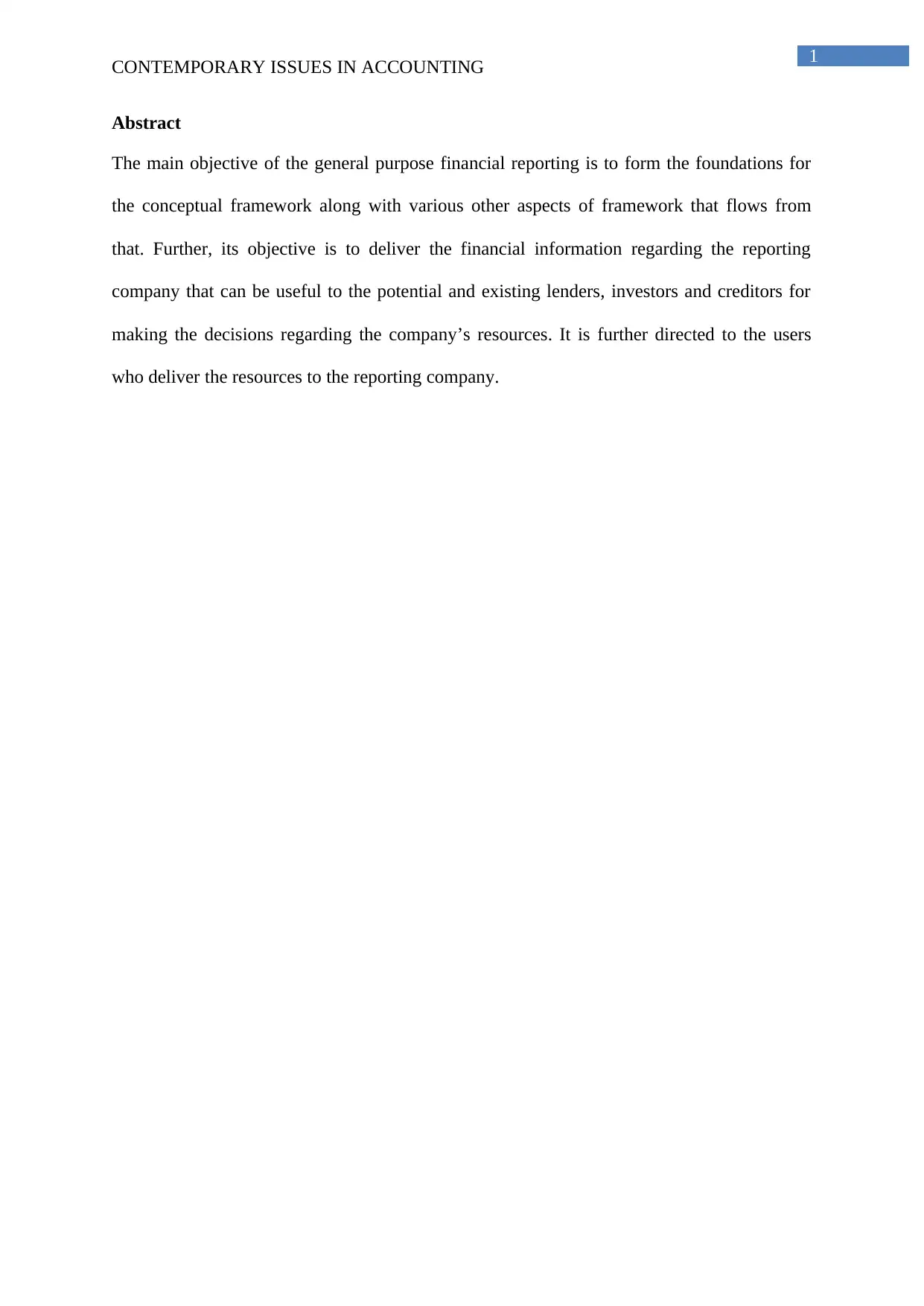
1
CONTEMPORARY ISSUES IN ACCOUNTING
Abstract
The main objective of the general purpose financial reporting is to form the foundations for
the conceptual framework along with various other aspects of framework that flows from
that. Further, its objective is to deliver the financial information regarding the reporting
company that can be useful to the potential and existing lenders, investors and creditors for
making the decisions regarding the company’s resources. It is further directed to the users
who deliver the resources to the reporting company.
CONTEMPORARY ISSUES IN ACCOUNTING
Abstract
The main objective of the general purpose financial reporting is to form the foundations for
the conceptual framework along with various other aspects of framework that flows from
that. Further, its objective is to deliver the financial information regarding the reporting
company that can be useful to the potential and existing lenders, investors and creditors for
making the decisions regarding the company’s resources. It is further directed to the users
who deliver the resources to the reporting company.
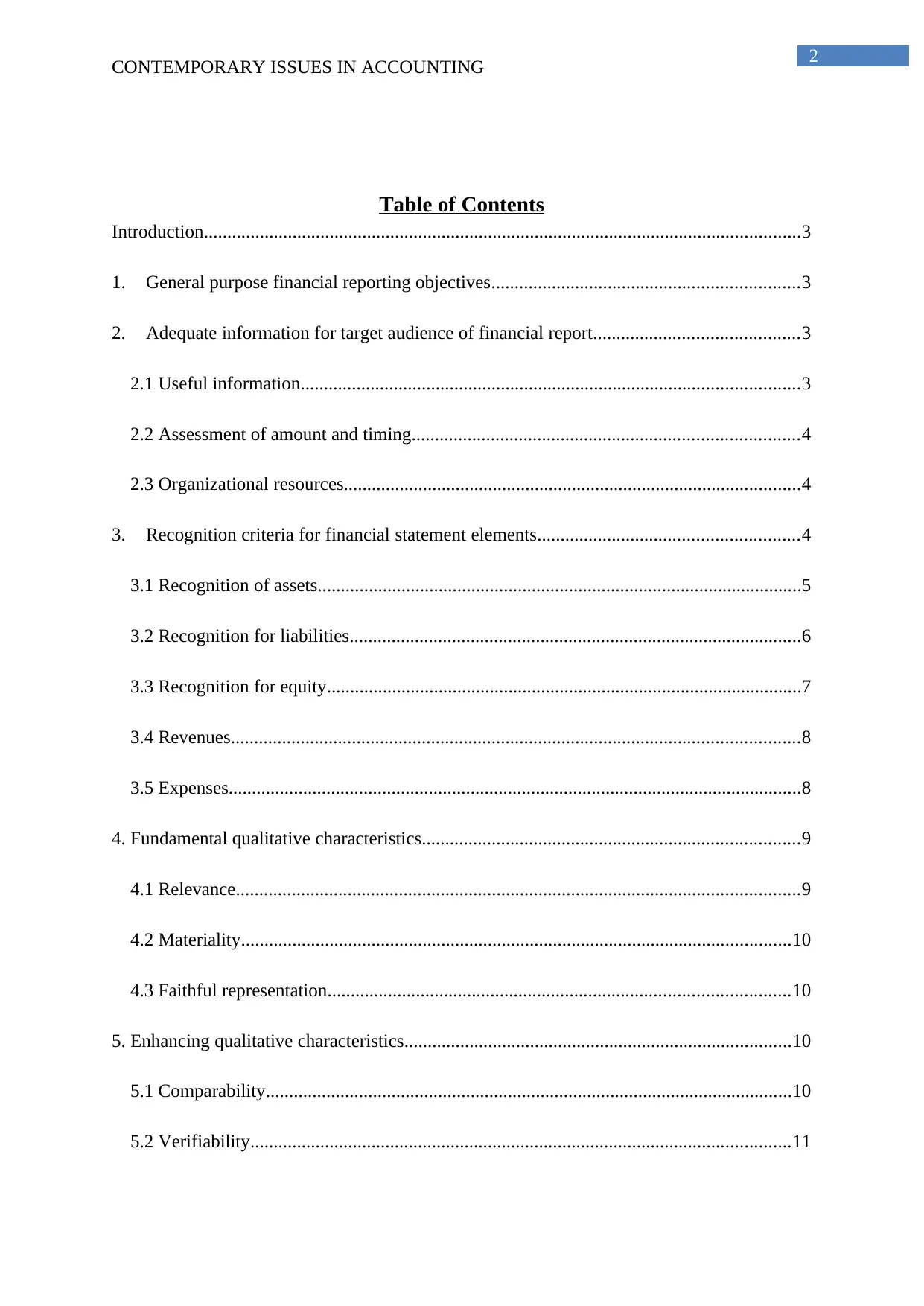
2
CONTEMPORARY ISSUES IN ACCOUNTING
Table of Contents
Introduction................................................................................................................................3
1. General purpose financial reporting objectives..................................................................3
2. Adequate information for target audience of financial report............................................3
2.1 Useful information...........................................................................................................3
2.2 Assessment of amount and timing...................................................................................4
2.3 Organizational resources..................................................................................................4
3. Recognition criteria for financial statement elements........................................................4
3.1 Recognition of assets........................................................................................................5
3.2 Recognition for liabilities.................................................................................................6
3.3 Recognition for equity......................................................................................................7
3.4 Revenues..........................................................................................................................8
3.5 Expenses...........................................................................................................................8
4. Fundamental qualitative characteristics.................................................................................9
4.1 Relevance.........................................................................................................................9
4.2 Materiality......................................................................................................................10
4.3 Faithful representation...................................................................................................10
5. Enhancing qualitative characteristics...................................................................................10
5.1 Comparability.................................................................................................................10
5.2 Verifiability....................................................................................................................11
CONTEMPORARY ISSUES IN ACCOUNTING
Table of Contents
Introduction................................................................................................................................3
1. General purpose financial reporting objectives..................................................................3
2. Adequate information for target audience of financial report............................................3
2.1 Useful information...........................................................................................................3
2.2 Assessment of amount and timing...................................................................................4
2.3 Organizational resources..................................................................................................4
3. Recognition criteria for financial statement elements........................................................4
3.1 Recognition of assets........................................................................................................5
3.2 Recognition for liabilities.................................................................................................6
3.3 Recognition for equity......................................................................................................7
3.4 Revenues..........................................................................................................................8
3.5 Expenses...........................................................................................................................8
4. Fundamental qualitative characteristics.................................................................................9
4.1 Relevance.........................................................................................................................9
4.2 Materiality......................................................................................................................10
4.3 Faithful representation...................................................................................................10
5. Enhancing qualitative characteristics...................................................................................10
5.1 Comparability.................................................................................................................10
5.2 Verifiability....................................................................................................................11
⊘ This is a preview!⊘
Do you want full access?
Subscribe today to unlock all pages.

Trusted by 1+ million students worldwide
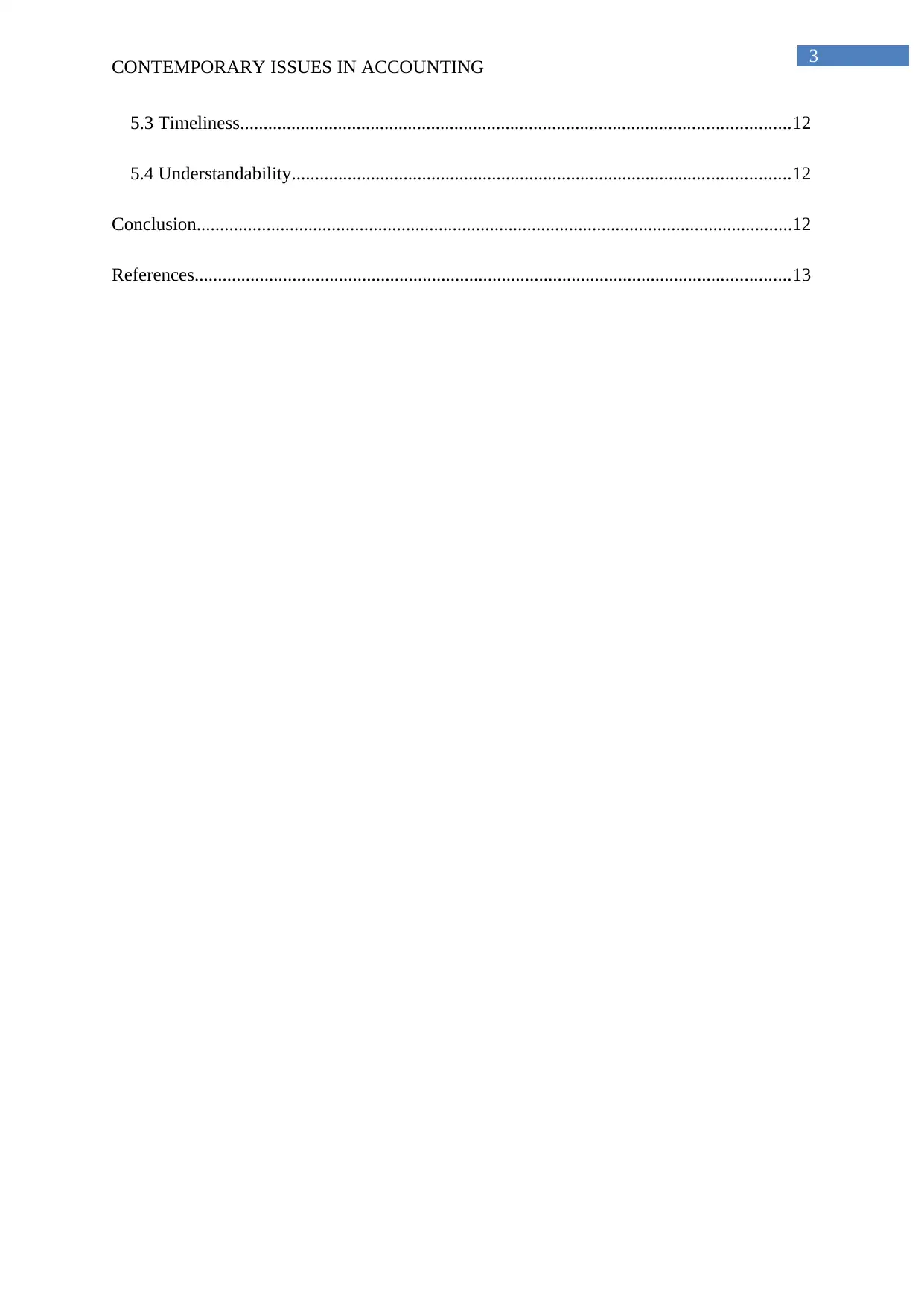
3
CONTEMPORARY ISSUES IN ACCOUNTING
5.3 Timeliness......................................................................................................................12
5.4 Understandability...........................................................................................................12
Conclusion................................................................................................................................12
References................................................................................................................................13
CONTEMPORARY ISSUES IN ACCOUNTING
5.3 Timeliness......................................................................................................................12
5.4 Understandability...........................................................................................................12
Conclusion................................................................................................................................12
References................................................................................................................................13
Paraphrase This Document
Need a fresh take? Get an instant paraphrase of this document with our AI Paraphraser
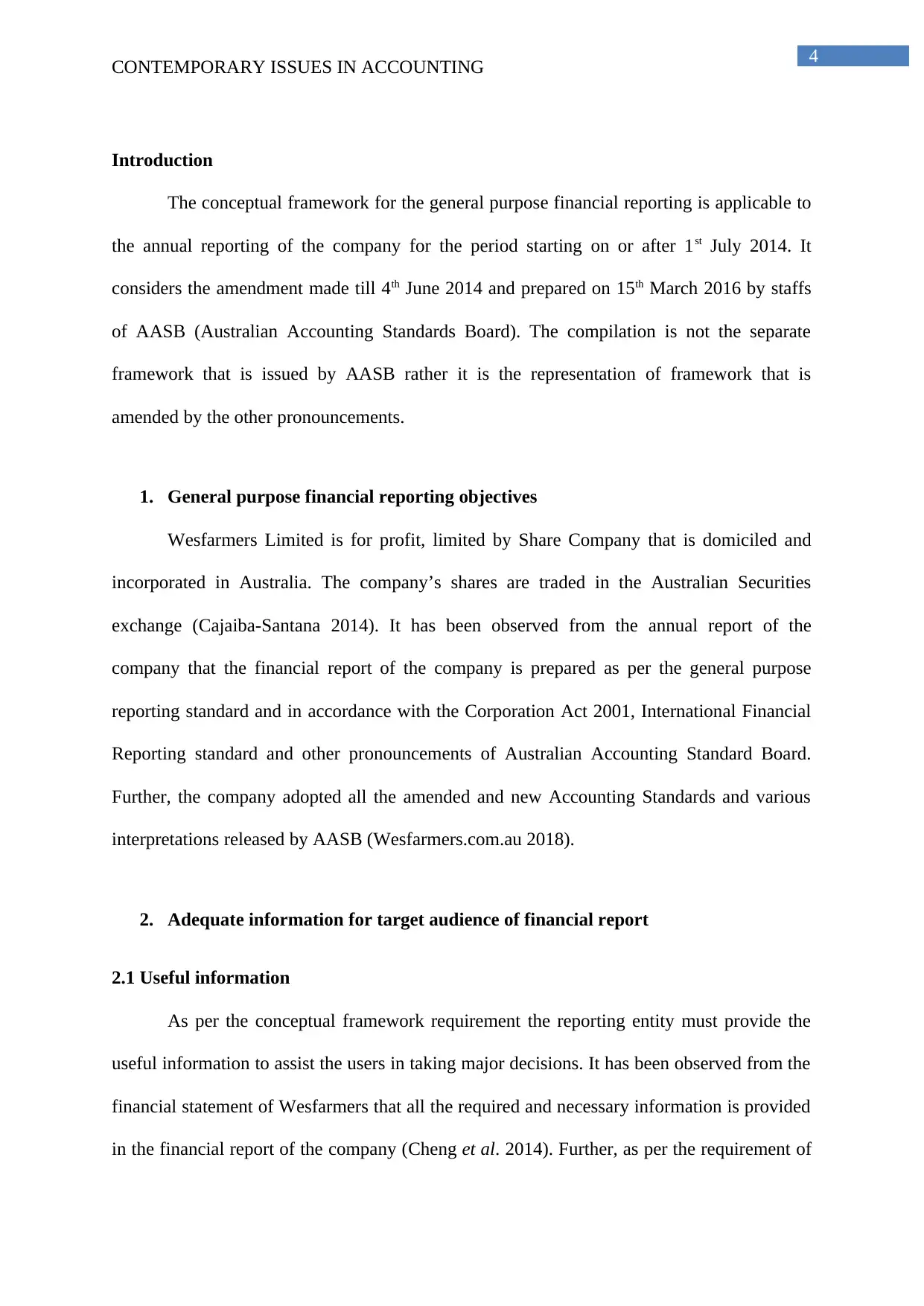
4
CONTEMPORARY ISSUES IN ACCOUNTING
Introduction
The conceptual framework for the general purpose financial reporting is applicable to
the annual reporting of the company for the period starting on or after 1st July 2014. It
considers the amendment made till 4th June 2014 and prepared on 15th March 2016 by staffs
of AASB (Australian Accounting Standards Board). The compilation is not the separate
framework that is issued by AASB rather it is the representation of framework that is
amended by the other pronouncements.
1. General purpose financial reporting objectives
Wesfarmers Limited is for profit, limited by Share Company that is domiciled and
incorporated in Australia. The company’s shares are traded in the Australian Securities
exchange (Cajaiba-Santana 2014). It has been observed from the annual report of the
company that the financial report of the company is prepared as per the general purpose
reporting standard and in accordance with the Corporation Act 2001, International Financial
Reporting standard and other pronouncements of Australian Accounting Standard Board.
Further, the company adopted all the amended and new Accounting Standards and various
interpretations released by AASB (Wesfarmers.com.au 2018).
2. Adequate information for target audience of financial report
2.1 Useful information
As per the conceptual framework requirement the reporting entity must provide the
useful information to assist the users in taking major decisions. It has been observed from the
financial statement of Wesfarmers that all the required and necessary information is provided
in the financial report of the company (Cheng et al. 2014). Further, as per the requirement of
CONTEMPORARY ISSUES IN ACCOUNTING
Introduction
The conceptual framework for the general purpose financial reporting is applicable to
the annual reporting of the company for the period starting on or after 1st July 2014. It
considers the amendment made till 4th June 2014 and prepared on 15th March 2016 by staffs
of AASB (Australian Accounting Standards Board). The compilation is not the separate
framework that is issued by AASB rather it is the representation of framework that is
amended by the other pronouncements.
1. General purpose financial reporting objectives
Wesfarmers Limited is for profit, limited by Share Company that is domiciled and
incorporated in Australia. The company’s shares are traded in the Australian Securities
exchange (Cajaiba-Santana 2014). It has been observed from the annual report of the
company that the financial report of the company is prepared as per the general purpose
reporting standard and in accordance with the Corporation Act 2001, International Financial
Reporting standard and other pronouncements of Australian Accounting Standard Board.
Further, the company adopted all the amended and new Accounting Standards and various
interpretations released by AASB (Wesfarmers.com.au 2018).
2. Adequate information for target audience of financial report
2.1 Useful information
As per the conceptual framework requirement the reporting entity must provide the
useful information to assist the users in taking major decisions. It has been observed from the
financial statement of Wesfarmers that all the required and necessary information is provided
in the financial report of the company (Cheng et al. 2014). Further, as per the requirement of
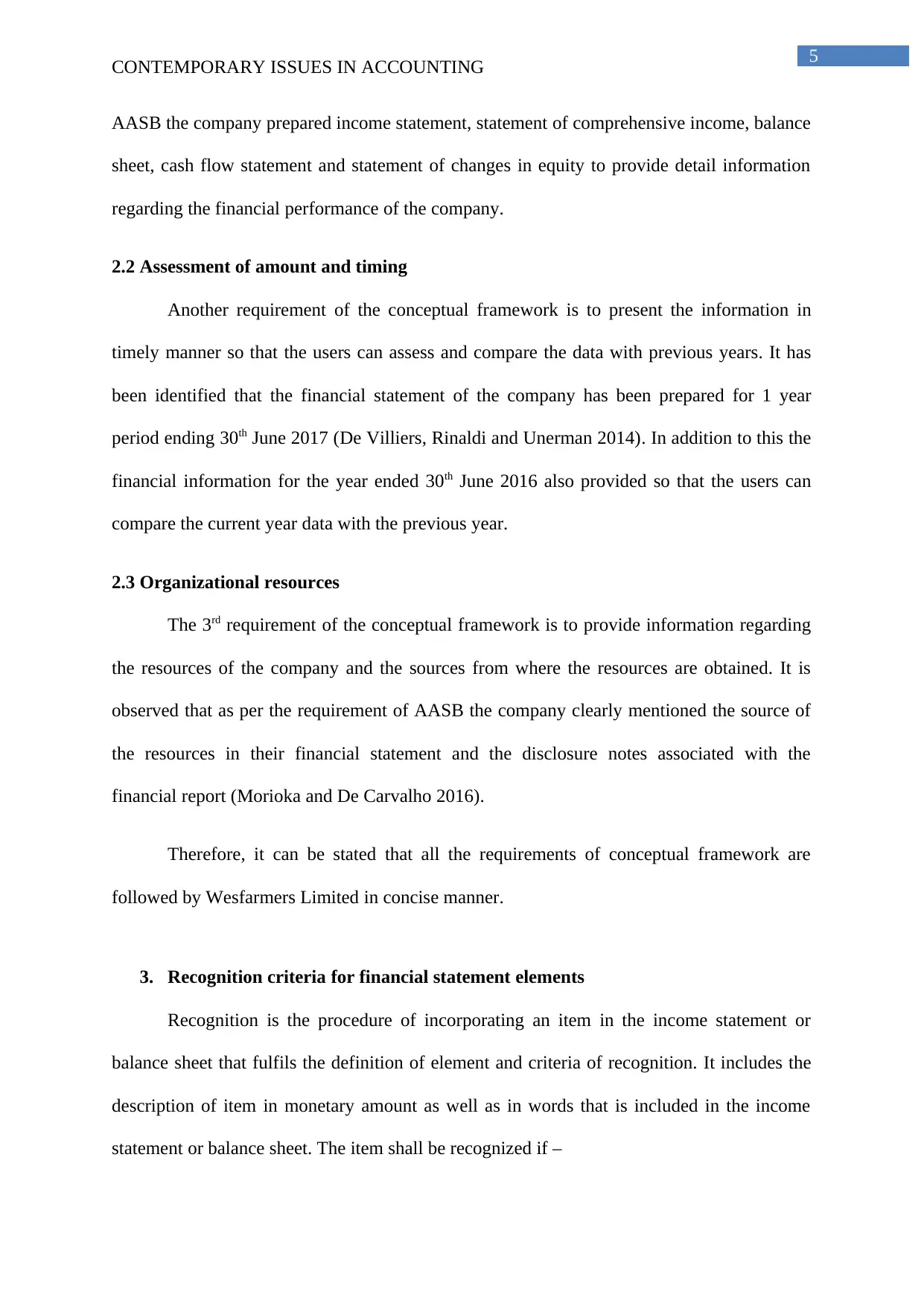
5
CONTEMPORARY ISSUES IN ACCOUNTING
AASB the company prepared income statement, statement of comprehensive income, balance
sheet, cash flow statement and statement of changes in equity to provide detail information
regarding the financial performance of the company.
2.2 Assessment of amount and timing
Another requirement of the conceptual framework is to present the information in
timely manner so that the users can assess and compare the data with previous years. It has
been identified that the financial statement of the company has been prepared for 1 year
period ending 30th June 2017 (De Villiers, Rinaldi and Unerman 2014). In addition to this the
financial information for the year ended 30th June 2016 also provided so that the users can
compare the current year data with the previous year.
2.3 Organizational resources
The 3rd requirement of the conceptual framework is to provide information regarding
the resources of the company and the sources from where the resources are obtained. It is
observed that as per the requirement of AASB the company clearly mentioned the source of
the resources in their financial statement and the disclosure notes associated with the
financial report (Morioka and De Carvalho 2016).
Therefore, it can be stated that all the requirements of conceptual framework are
followed by Wesfarmers Limited in concise manner.
3. Recognition criteria for financial statement elements
Recognition is the procedure of incorporating an item in the income statement or
balance sheet that fulfils the definition of element and criteria of recognition. It includes the
description of item in monetary amount as well as in words that is included in the income
statement or balance sheet. The item shall be recognized if –
CONTEMPORARY ISSUES IN ACCOUNTING
AASB the company prepared income statement, statement of comprehensive income, balance
sheet, cash flow statement and statement of changes in equity to provide detail information
regarding the financial performance of the company.
2.2 Assessment of amount and timing
Another requirement of the conceptual framework is to present the information in
timely manner so that the users can assess and compare the data with previous years. It has
been identified that the financial statement of the company has been prepared for 1 year
period ending 30th June 2017 (De Villiers, Rinaldi and Unerman 2014). In addition to this the
financial information for the year ended 30th June 2016 also provided so that the users can
compare the current year data with the previous year.
2.3 Organizational resources
The 3rd requirement of the conceptual framework is to provide information regarding
the resources of the company and the sources from where the resources are obtained. It is
observed that as per the requirement of AASB the company clearly mentioned the source of
the resources in their financial statement and the disclosure notes associated with the
financial report (Morioka and De Carvalho 2016).
Therefore, it can be stated that all the requirements of conceptual framework are
followed by Wesfarmers Limited in concise manner.
3. Recognition criteria for financial statement elements
Recognition is the procedure of incorporating an item in the income statement or
balance sheet that fulfils the definition of element and criteria of recognition. It includes the
description of item in monetary amount as well as in words that is included in the income
statement or balance sheet. The item shall be recognized if –
⊘ This is a preview!⊘
Do you want full access?
Subscribe today to unlock all pages.

Trusted by 1+ million students worldwide

6
CONTEMPORARY ISSUES IN ACCOUNTING
The particular item has a value or cost that can be reliably measured, and
It is apparent that the future economic benefits, if any related to the item will flow
from or to the entity.
3.1 Recognition of assets
Assets are recognized under the balance sheet if it is apparent that the future economic
benefits, if any related to the asset will flow from or to the entity. It has been identified from
the balance sheet of the company that the company has various assets that are segregated
under current assets and non-current assets. Carrying value of the plant, property and
equipment are measured at the cost of asset reduced by impairment and depreciation. Further
the asset’s cost is inclusive of the cost of replacing that is eligible for capitalisation and cost
involved in major inspections (Wesfarmers.com.au 2018)..
Further, the goodwill and intangible assets acquired under the business combination
are measure at cost initially. Cost of the intangible asset that is acquired under the business
combination is the fair value on the acquisition date. However, after the initial recognition the
intangible assets are recorded at the cost reduced by amortisation and impairment loss, if any.
CONTEMPORARY ISSUES IN ACCOUNTING
The particular item has a value or cost that can be reliably measured, and
It is apparent that the future economic benefits, if any related to the item will flow
from or to the entity.
3.1 Recognition of assets
Assets are recognized under the balance sheet if it is apparent that the future economic
benefits, if any related to the asset will flow from or to the entity. It has been identified from
the balance sheet of the company that the company has various assets that are segregated
under current assets and non-current assets. Carrying value of the plant, property and
equipment are measured at the cost of asset reduced by impairment and depreciation. Further
the asset’s cost is inclusive of the cost of replacing that is eligible for capitalisation and cost
involved in major inspections (Wesfarmers.com.au 2018)..
Further, the goodwill and intangible assets acquired under the business combination
are measure at cost initially. Cost of the intangible asset that is acquired under the business
combination is the fair value on the acquisition date. However, after the initial recognition the
intangible assets are recorded at the cost reduced by amortisation and impairment loss, if any.
Paraphrase This Document
Need a fresh take? Get an instant paraphrase of this document with our AI Paraphraser
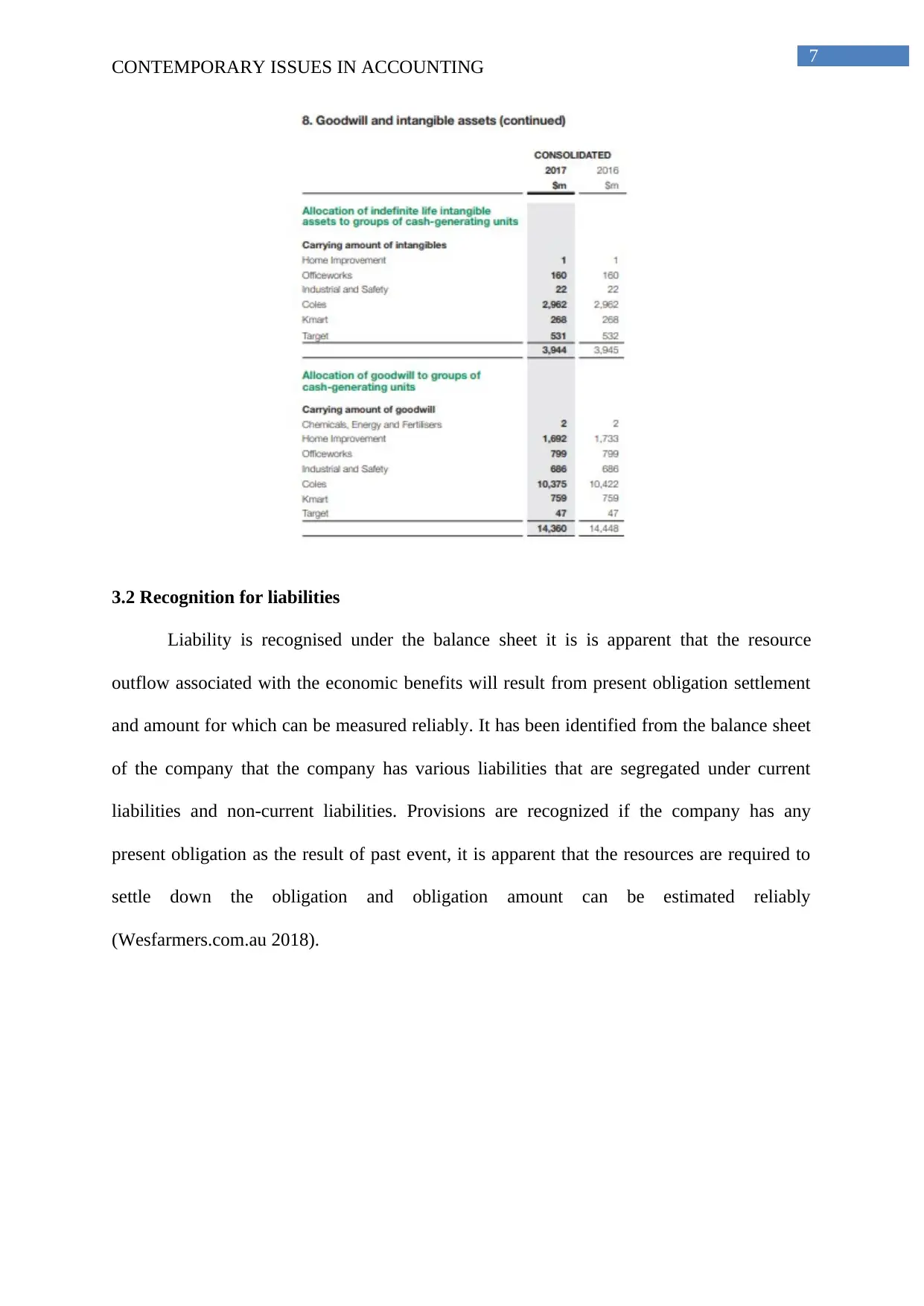
7
CONTEMPORARY ISSUES IN ACCOUNTING
3.2 Recognition for liabilities
Liability is recognised under the balance sheet it is is apparent that the resource
outflow associated with the economic benefits will result from present obligation settlement
and amount for which can be measured reliably. It has been identified from the balance sheet
of the company that the company has various liabilities that are segregated under current
liabilities and non-current liabilities. Provisions are recognized if the company has any
present obligation as the result of past event, it is apparent that the resources are required to
settle down the obligation and obligation amount can be estimated reliably
(Wesfarmers.com.au 2018).
CONTEMPORARY ISSUES IN ACCOUNTING
3.2 Recognition for liabilities
Liability is recognised under the balance sheet it is is apparent that the resource
outflow associated with the economic benefits will result from present obligation settlement
and amount for which can be measured reliably. It has been identified from the balance sheet
of the company that the company has various liabilities that are segregated under current
liabilities and non-current liabilities. Provisions are recognized if the company has any
present obligation as the result of past event, it is apparent that the resources are required to
settle down the obligation and obligation amount can be estimated reliably
(Wesfarmers.com.au 2018).
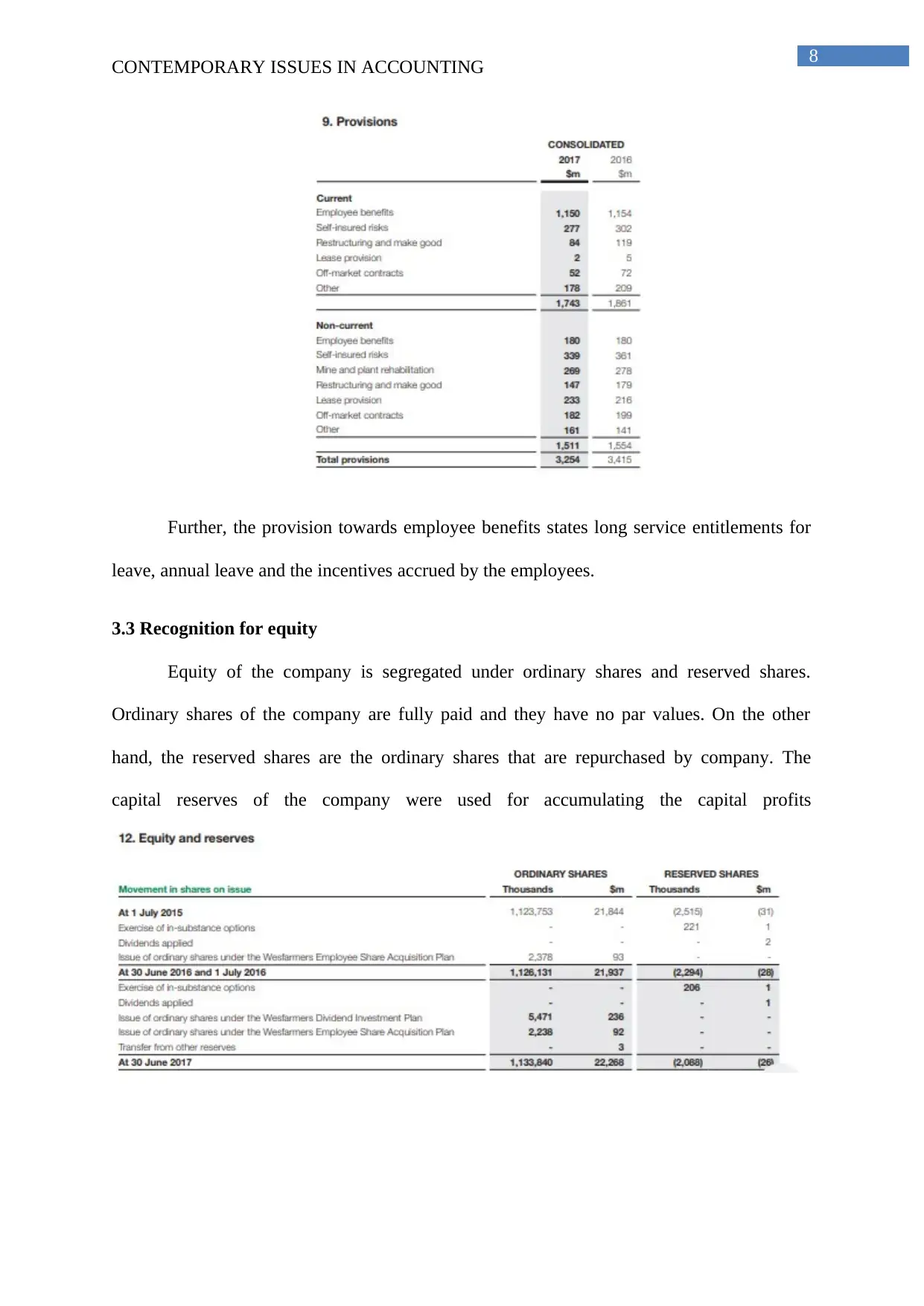
8
CONTEMPORARY ISSUES IN ACCOUNTING
Further, the provision towards employee benefits states long service entitlements for
leave, annual leave and the incentives accrued by the employees.
3.3 Recognition for equity
Equity of the company is segregated under ordinary shares and reserved shares.
Ordinary shares of the company are fully paid and they have no par values. On the other
hand, the reserved shares are the ordinary shares that are repurchased by company. The
capital reserves of the company were used for accumulating the capital profits
CONTEMPORARY ISSUES IN ACCOUNTING
Further, the provision towards employee benefits states long service entitlements for
leave, annual leave and the incentives accrued by the employees.
3.3 Recognition for equity
Equity of the company is segregated under ordinary shares and reserved shares.
Ordinary shares of the company are fully paid and they have no par values. On the other
hand, the reserved shares are the ordinary shares that are repurchased by company. The
capital reserves of the company were used for accumulating the capital profits
⊘ This is a preview!⊘
Do you want full access?
Subscribe today to unlock all pages.

Trusted by 1+ million students worldwide

9
CONTEMPORARY ISSUES IN ACCOUNTING
3.4 Revenues
Revenues are recognised under the income statement while the increase in future
economic benefit associated with the decrease in liability or increase in asset has taken place
that can be measured reliably. It is identified from the financial statement of Wesfarmers
Limited that the revenues are measured at fair value of consideration receivable or received.
Further the revenues are recognized if only it meets the required criteria. Further the revenues
are recognized if the significant rewards and risks of the ownership related to the goods
passed to buyer and can be reliably measured. Rewards and risks are considered as
transferred to the buyer at the delivery time of the goods to customer.
3.5 Expenses
The expenses under the income statement are recognized if the decrease in the future
income benefits associated with the increase in liability or decrease in assets has increased
and can be measured reliably (A Review of the IASB’s Conceptual Framework for Financial
Reporting 2018). It can be identified from the financial statements of Wesfarmers Limited
that segregation and details regarding various expenses like employee benefit expenses,
CONTEMPORARY ISSUES IN ACCOUNTING
3.4 Revenues
Revenues are recognised under the income statement while the increase in future
economic benefit associated with the decrease in liability or increase in asset has taken place
that can be measured reliably. It is identified from the financial statement of Wesfarmers
Limited that the revenues are measured at fair value of consideration receivable or received.
Further the revenues are recognized if only it meets the required criteria. Further the revenues
are recognized if the significant rewards and risks of the ownership related to the goods
passed to buyer and can be reliably measured. Rewards and risks are considered as
transferred to the buyer at the delivery time of the goods to customer.
3.5 Expenses
The expenses under the income statement are recognized if the decrease in the future
income benefits associated with the increase in liability or decrease in assets has increased
and can be measured reliably (A Review of the IASB’s Conceptual Framework for Financial
Reporting 2018). It can be identified from the financial statements of Wesfarmers Limited
that segregation and details regarding various expenses like employee benefit expenses,
Paraphrase This Document
Need a fresh take? Get an instant paraphrase of this document with our AI Paraphraser
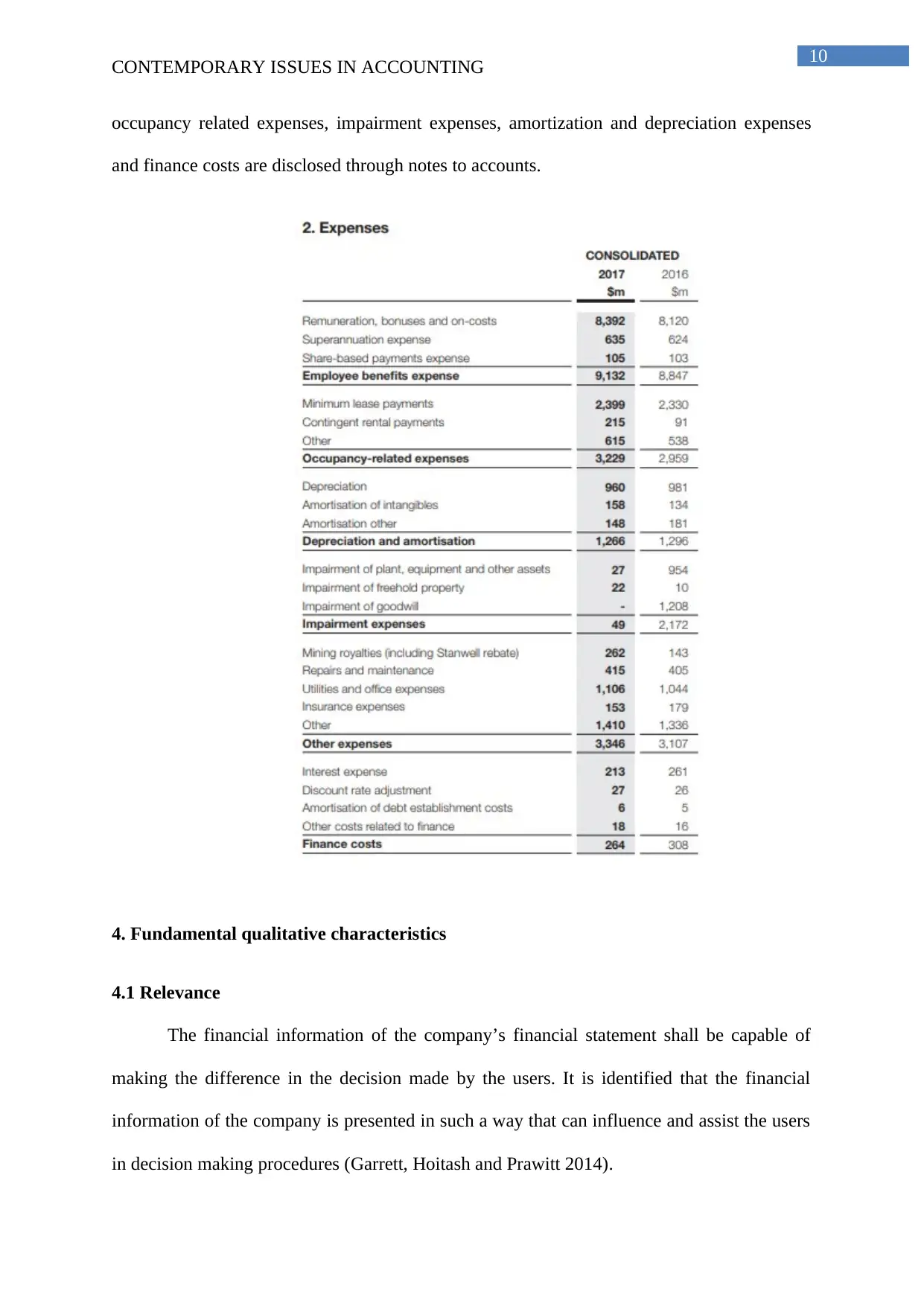
10
CONTEMPORARY ISSUES IN ACCOUNTING
occupancy related expenses, impairment expenses, amortization and depreciation expenses
and finance costs are disclosed through notes to accounts.
4. Fundamental qualitative characteristics
4.1 Relevance
The financial information of the company’s financial statement shall be capable of
making the difference in the decision made by the users. It is identified that the financial
information of the company is presented in such a way that can influence and assist the users
in decision making procedures (Garrett, Hoitash and Prawitt 2014).
CONTEMPORARY ISSUES IN ACCOUNTING
occupancy related expenses, impairment expenses, amortization and depreciation expenses
and finance costs are disclosed through notes to accounts.
4. Fundamental qualitative characteristics
4.1 Relevance
The financial information of the company’s financial statement shall be capable of
making the difference in the decision made by the users. It is identified that the financial
information of the company is presented in such a way that can influence and assist the users
in decision making procedures (Garrett, Hoitash and Prawitt 2014).
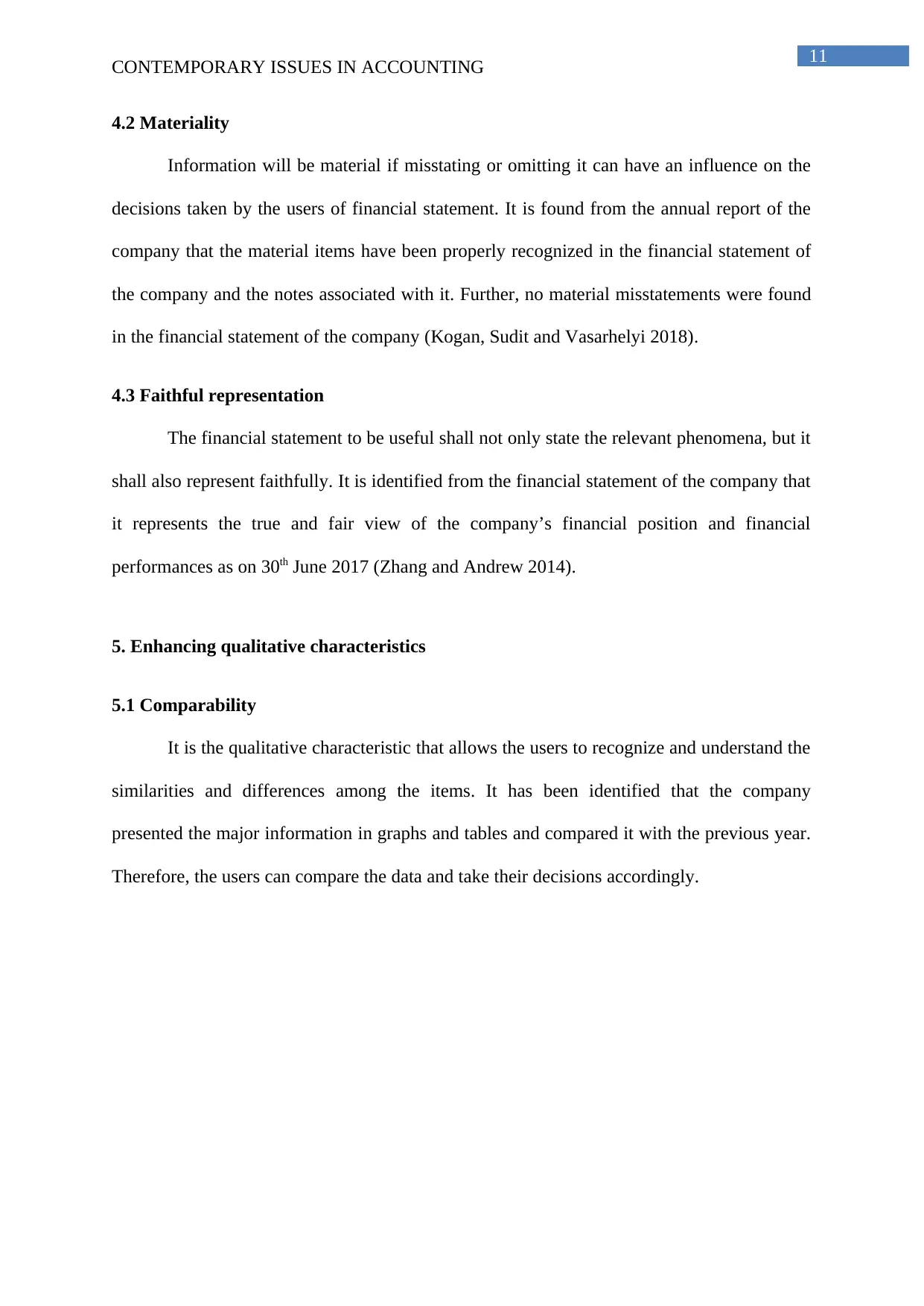
11
CONTEMPORARY ISSUES IN ACCOUNTING
4.2 Materiality
Information will be material if misstating or omitting it can have an influence on the
decisions taken by the users of financial statement. It is found from the annual report of the
company that the material items have been properly recognized in the financial statement of
the company and the notes associated with it. Further, no material misstatements were found
in the financial statement of the company (Kogan, Sudit and Vasarhelyi 2018).
4.3 Faithful representation
The financial statement to be useful shall not only state the relevant phenomena, but it
shall also represent faithfully. It is identified from the financial statement of the company that
it represents the true and fair view of the company’s financial position and financial
performances as on 30th June 2017 (Zhang and Andrew 2014).
5. Enhancing qualitative characteristics
5.1 Comparability
It is the qualitative characteristic that allows the users to recognize and understand the
similarities and differences among the items. It has been identified that the company
presented the major information in graphs and tables and compared it with the previous year.
Therefore, the users can compare the data and take their decisions accordingly.
CONTEMPORARY ISSUES IN ACCOUNTING
4.2 Materiality
Information will be material if misstating or omitting it can have an influence on the
decisions taken by the users of financial statement. It is found from the annual report of the
company that the material items have been properly recognized in the financial statement of
the company and the notes associated with it. Further, no material misstatements were found
in the financial statement of the company (Kogan, Sudit and Vasarhelyi 2018).
4.3 Faithful representation
The financial statement to be useful shall not only state the relevant phenomena, but it
shall also represent faithfully. It is identified from the financial statement of the company that
it represents the true and fair view of the company’s financial position and financial
performances as on 30th June 2017 (Zhang and Andrew 2014).
5. Enhancing qualitative characteristics
5.1 Comparability
It is the qualitative characteristic that allows the users to recognize and understand the
similarities and differences among the items. It has been identified that the company
presented the major information in graphs and tables and compared it with the previous year.
Therefore, the users can compare the data and take their decisions accordingly.
⊘ This is a preview!⊘
Do you want full access?
Subscribe today to unlock all pages.

Trusted by 1+ million students worldwide
1 out of 16
Related Documents
Your All-in-One AI-Powered Toolkit for Academic Success.
+13062052269
info@desklib.com
Available 24*7 on WhatsApp / Email
![[object Object]](/_next/static/media/star-bottom.7253800d.svg)
Unlock your academic potential
Copyright © 2020–2025 A2Z Services. All Rights Reserved. Developed and managed by ZUCOL.

![Report: Contemporary Issues in Accounting - [University Name]](/_next/image/?url=https%3A%2F%2Fdesklib.com%2Fmedia%2Fimages%2Fzz%2F9509ff46c136422d929242036a52e1cb.jpg&w=256&q=75)

